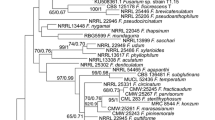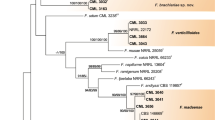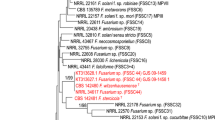Abstract
Six new species of Fusarium associated with soil and plant hosts from ecosystems of minimal anthropogenic disturbance in Australia are described. Fusarium coicis from Coix gasteenii, F. goolgardi from Xanthorrhoea glauca, F. mundagurra from soil and Mangifera indica, F. newnesense from soil, F. tjaetaba from Sorghum interjectum and F. tjaynera from soil, Triodia microstachya, Sorghum interjectum and Sorghum intrans. Morphology and phylogenetic analysis of EF-1α, RPB1 and RPB2 sequence data were used to delineate species boundaries. The new species were phylogenetically distributed in the Fusarium sambucinum, F. fujikuroi, and F. chlamydosporum species complexes, and two novel species complexes. These six new species have particular phylogeographic significance as not only do they provide further insight into the geographic patterns of Fusarium evolution but also challenge current phylogeographic hypotheses.









Similar content being viewed by others
References
Baayen RP, O’Donnell K, Breeuwsma S, Geiser DM, Waalwijk C (2001) Molecular relationships of fungi within the Fusarium redolens F. hostae clade. Phytopathology 91(11):1037–1044
Backhouse D, Burgess LW, Summerell BA (2001) Biogeography of Fusarium. In: Summerell BA, Leslie JF, Backhouse D, Bryden W, Burgess LW (eds) Fusarium. The American Phytopathology Society, Minnesota, pp 122–137
Benyon F, Burgess L, Sharp P (2000) Molecular genetic investigations and reclassification of Fusarium species in sections Fusarium and Roseum. Mycol Res 104(10):1164–1174
Boutati EI, Anaissie EJ (1997) Fusarium, a significant emerging pathogen in patients with hematologic malignancy: ten years’ experience at a cancer center and implications for management. Blood 90(3):999–1008
Bryden WL (2012) Mycotoxin contamination of the feed supply chain: implications for animal productivity and feed security. Anim Feed Sci Technol 173(1–2):134–158. doi:10.1016/j.anifeedsci.2011.12.014
Burgess LW (1981) General ecology of fusaria. Fusarium: diseases, biology and taxonomy. Pennsylvania State University Press, Pennsylvania
Burgess LW (2014) 2011 McAlpine memorial lecture - a love affair with Fusarium. Australas Plant Pathol 43(4):359–368. doi:10.1007/s13313-013-0261-8
Burgess LW, Liddell CM, Summerell BA (1994a) Laboratory manual for Fusarium research. Laboratory manual for Fusarium research, 3rd edn. University of Sydney, Sydney
Burgess LW, Summerell BA (1992) Mycogeography of Fusarium - survey of Fusarium species in subtropical and semiarid grassland soils from Queensland, Australia. Mycol Res 96:780–784
Burgess LW, Summerell BA, Bullock S, Gott KP, Backhouse D (1994b) Laboratory manual for Fusarium research, 3rd edn. The University of Sydney, Sydney
Burgess LW, Trimboli D (1986) Characterization and distribution of Fusarium nygamai, sp. nov. Mycologia 78(2):223–229
Carbone I, Kohn LM (1999) A method for designing primer sets for speciation studies in filamentous ascomycetes. Mycologia 91(3):553–556
Desjardins AE (2006) Fusarium mycotoxins : Chemistry, genetics and biology. APS Press, St. Paul
Desjardins AE, Hohn TM (1997) Mycotoxins in plant pathogenesis. Mol Plant-Microbe Interact 10(2):147–152. doi:10.1094/mpmi.1997.10.2.147
Drummond AJ, Ashton B, Buxton S, Cheung M, Cooper A, Duran C, Field M, Heled J, Kearse M, Markowitz S, Moir R, Stones-Havas S, Sturrock S, Thierer T, Wilson A Geneious v5.4 (2011) Geneious v5.4
Elmer WH, LaMondia JA, Caruso FL (2012) Association between Fusarium spp. on Spartina alterniflora and dieback sites in Connecticut and Massachusetts. Estuar Coasts 35(2):436–444. doi:10.1007/s12237-011-9448-9
Elmer WH, Marra RE (2011) New species of Fusarium associated with dieback of Spartina alterniflora in Atlantic salt marshes. Mycologia 103(4):806–819. doi:10.3852/10-155
Fisher NL, Burgess LW, Toussoun TA, Nelson PE (1982) Carnation leaves as a substrate and for preserving cultures of Fusarium species. Phytopathology 72(1):151–153
Gams W, Klamer M, O’Donnell K (1999) Fusarium miscanthi sp. nov. from Miscanthus litter. Mycologia 91:263–268
Gordon TR, Martyn RD (1997) The evolutionary biology of Fusarium oxysporum. Annu Rev Phytopathol 35:111–128
Gräfenhan T, Schroers HJ, Nirenberg HI, Seifert KA (2011) An overview of the taxonomy, phylogeny, and typification of nectriaceous fungi in Cosmospora, Acremonium, Fusarium, Stilbella, and Volutella. Stud Mycol 68:79–113
Hasegawa M, Kishino H, Yano TA (1985) Dating of the human ape splitting by a molecular clock of mitochondrial-DNA. J Mol Evol 22(2):160–174
Hillis DM, Pollock DD, McGuire JA, Zwickl DJ (2003) Is sparse taxon sampling a problem for phylogenetic inference? Syst Biol 52(1):124–126
Huelsenbeck JP (2001) MRBAYES: Bayesian inference of phylogenetic trees. Bioinformatics 17:754–755
Kirk PM, Ainsworth GC, Bisby GR, International CAB (2008) Ainsworth & Bisby’s dictionary of the fungi. CABI, Wallingford
Kornerup A (1978) Methuen handbook of colour, 3rd edn. Methuen London Ltd, London
Kvas M, Marasas WFO, Wingfield BD, Wingfield MJ, Steenkamp ET (2009) Diversity and evolution of Fusarium species in the Gibberella fujikuroi complex. Fungal Divers 34:1–21
Laurence M, Summerell B, Burgess L, Liew E (2011) Fusarium burgessii sp. nov. representing a novel lineage in the genus Fusarium. Fungal Divers 49(1):101–112
Laurence MH, Burgess LW, Summerell BA, Liew ECY (2012) High levels of diversity in Fusarium oxysporum from non-cultivated ecosystems in Australia. Fungal Biol 116(2):289–297
Laurence MH, Summerell BA, Burgess LW, Liew ECY (2014) Genealogical concordance phylogenetic species recognition in the Fusarium oxysporum species complex. Fungal Biol 118(4):374–384. doi:10.1016/j.funbio.2014.02.002
Leslie JF, Summerell BA (2006) The Fusarium Laboratory manual, 1st edn. Blackwell Publishing, Iowa
Leslie JF, Zeller KA, Summerell BA (2001) Icebergs and species in populations of Fusarium. Physiol Mol Plant Pathol 59(3):107–117
Marasas WFO, Nelson PE, Toussoun TA (1984) Toxigenic Fusarium species, identity and mycotoxicology. Pennsylvania State University Press, University Park, USA
Mitchell JS, Attleber MH (1973) Fusarium Keratomycosis in horse. Vet Med Small AnimClin 68(11):1257–1260
Nelson PE (1991) History of Fusarium systematics. Phytopathology 81(9):1045–1048
Nelson PE, Toussoun TA, Burgess LW (1987) Characterization of Fusarium beomiforme sp. nov. Mycologia 79(6):884–889. doi:10.2307/3807690
Nelson PE, Toussoun TA, Marasas WFO (1983) Fusarium species : An illustrated manual for identification. Pennsylvania State University Press, University Park
Nirenberg H (1976) Untersuchungen über die morphologische und biologische Differenzierung in der Fusarium-Sektion Liseola. Parey
Nirenberg H, Aoki T (1997) Fusarium nisikadoi, a new species from Japan. Mycoscience 38:329–333
O’Donnell K (2000) Molecular phylogeny of the Nectria haematococca-Fusarium solani species complex. Mycologia 92(5):919–938
O’Donnell K, Cigelnik E, Nirenberg HI (1998a) Molecular systematics and phylogeography of the Gibberella fujikuroi species complex. Mycologia 90(3):465–493
O’Donnell K, Kistler HC, Cigelnik E, Ploetz RC (1998b) Multiple evolutionary origins of the fungus causing Panama disease of banana: concordant evidence from nuclear and mitochondrial gene genealogies. Proc Natl Acad Sci U S A 95(5):2044–2049
O’Donnell K, Nirenberg HI, Aoki T, Cigelnik E (2000) A multigene phylogeny of the Gibberella fujikuroi species complex: detection of additional phylogenetically distinct species. Mycoscience 41(1):61–78
O’Donnell K, Sarver BAJ, Brandt M, Chang DC, Noble-Wang J, Park BJ, Sutton DA, Benjamin L, Lindsley M, Padhye A, Geiser DM, Ward TJ (2007) Phylogenetic diversity and microsphere array-based genotyping of human pathogenic fusaria, including isolates from the multistate contact lens - Associated US Keratitis outbreaks of 2005 and 2006. J Clin Microbiol 45(7):2235–2248
O’Donnell K, Sutton DA, Rinaldi MG, Sarver BA, Balajee SA, Schroers HJ, Summerbell RC, Robert VA, Crous PW, Zhang N, Aoki T, Jung K, Park J, Lee YH, Kang S, Park B, Geiser DM (2010) Internet-accessible DNA sequence database for identifying fusaria from human and animal infections. J Clin Microbiol 48(10):3708–3718
O’Donnell K, Ward TJ, Geiser DM, Kistler HC, Aoki T (2004) Genealogical concordance between the mating type locus and seven other nuclear genes supports formal recognition of nine phylogenetically distinct species within the Fusarium graminearum clade. Fungal Genet Biol 41(6):600–623
O’Donnell K, Rooney AP, Proctor RH, Brown DW, McCormick SP, Ward TJ, Frandsen RJN, Lysøe E, Rehner SA, Aoki T, Robert VARG, Crous PW, Groenewald JZ, Kang S, Geiser DM (2013) Phylogenetic analyses of RPB1 and RPB2 support a middle Cretaceous origin for a clade comprising all agriculturally and medically important fusaria. Fungal Genet Biol 52:20–31. doi:10.1016/j.fgb.2012.12.004
Phan HT, Burgess LW, Summerell BA, Bullock S, Liew ECY, Smith-White JL, Clarkson JR (2004) Gibberella gaditjirrii (Fusarium gaditjirri) sp. nov., a new species from tropical Grasslands in Australia. Stud Mycol 50:261–272
Pollock DD, Zwickl DJ, McGuire JA, Hillis DM (2002) Increased taxon sampling is advantageous for phylogenetic inference. Syst Biol 51(4):664–671
Posada D, Crandall KA (1998) MODELTEST: testing the model of DNA substitution. Bioinformatics 14(9):817–818
Proctor RH, Desjardins AE, McCormick SP, Plattner RD, Alexander NJ, Brown DW (2002) Genetic analysis of the role of trichothecene and fumonisin mycotoxins in the virulence of Fusarium. In: Logrieco A, Bailey JA, Corazza L, Cooke BM (eds) Mycotoxins in plant disease. Springer, Netherlands, pp 691–698. doi:10.1007/978-94-010-0001-7_12
Rambaut A (2013) FigTree (http://tree.bio.ed.ac.uk/software/figtree/). http://tree.bio.ed.ac.uk/software/figtree/. Accessed 6.2.2014
Reeb V, Lutzoni F, Roux C (2004) Contribution of RPB2 to multilocus phylogenetic studies of the euascomycetes (Pezizomycotina, Fungi) with special emphasis on the lichen-forming Acarosporaceae and evolution of polyspory. Mol Phylogenet Evol 32(3):1036–1060
Sangalang A, Summerell B, Burgess L, Backhouse D (1995a) Taxonomy of Fusarium: characterisation of Fusarium avenaceum subsp. aywerte and Fusarium avenaceum subsp. nurragi. Mycol Res 99(3):287–290
Sangalang AE (1992) Ecology and Taxonomy of Fusarium Species. PhD, The University of Sydney, Sydney
Sangalang AE, Burgess LW, Backhouse D, Duff J, Wurst M (1995b) Mycogeography of Fusarium species in soils from tropical, arid and Mediterranean Regions of Australia. Mycol Res 99:523–528
Schroers HJ, Baayen RP, Meffert JP, de Gruyter J, Hooftman M, O’Donnell K (2004) Fusarium foetens, a new species pathogenic to begonia elatior hybrids (Begonia X hiemalis) and the sister taxon of the Fusarium oxysporum species complex. Mycologia 96(2):393–406
Simon BK (1989) A new species of Coix L. (Poaceae) from Australia. Austrobaileya 3:1–5
Summerell BA, Laurence MH, Liew ECY, Leslie JF (2010) Biogeography and phylogeography of Fusarium: a review. Fungal Divers 44(1):1–11
Summerell BA, Leslie JF (2011) Fifty years of Fusarium: how could nine species have ever been enough? Fungal Divers 50(1):135–144. doi:10.1007/s13225-011-0132-y
Summerell BA, Rugg CA, Burgess LW (1993) Mycogeography of Fusarium - survey of Fusarium species associated with forest and woodland communities in north. Queensland, Australia. Mycol Res 97:1015–1019
Summerell BA, Rugg CA, Burgess LW (1995) Characterization of Fusarium babinda sp. nov. Mycol Res 99:1345–1348
Swofford DL (2002) PAUP*. Phylogenetic Analysis Using Parsimony (*and Other Methods). vol Version 4. Sinauer Associates, Sunderland,Massachusetts
Thompson JD, Gibson TJ, Plewniak F, Jeanmougin F, Higgins DG (1997) The ClustalX windows interface: flexible strategies for multiple sequence alignment aided by quality analysis tools. Nucleic Acids Res 24:4876–4882
Walsh J, Laurence M, Liew E, Sangalang A, Burgess L, Summerell B, Petrovic T (2010) Fusarium: two endophytic novel species from tropical grasses of northern Australia. Fungal Divers 44(1):149–159
Walsh JL (2007) Fusarium species associated with savanna ecosystems in Australia : Taxonomy, ecology and pathogenicity. University of Sydney, Sydney
Zwickl DJ, Hillis DM (2002) Increased taxon sampling greatly reduces phylogenetic error. Syst Biol 51(4):588–598
Acknowledgments
We would like to thank Emma Laurence and Dr Victoria Ludowici for preparation of the figures and table and Dr Ian Cowie and Dr John Clarkson for advice and assistance with field work and plant taxonomy. We also thank Dr Peter Wilson for his advice on botanical nomenclature. The authors would also like to thank The University of Sydney and The Royal Botanic Gardens and Domain Trust for their continued support
Author information
Authors and Affiliations
Corresponding author
Rights and permissions
About this article
Cite this article
Laurence, M.H., Walsh, J.L., Shuttleworth, L.A. et al. Six novel species of Fusarium from natural ecosystems in Australia. Fungal Diversity 77, 349–366 (2016). https://doi.org/10.1007/s13225-015-0337-6
Received:
Accepted:
Published:
Issue Date:
DOI: https://doi.org/10.1007/s13225-015-0337-6




